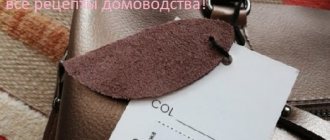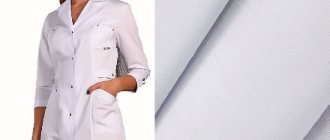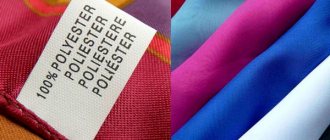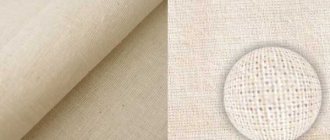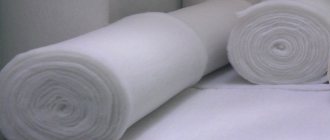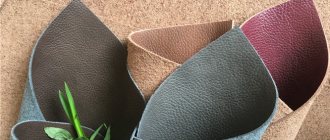What is artificial leather made of and types?
There are many technologies for making leather fabric. The most common are:
- The direct method is to apply a polymer coating to a textile base (smooth synthetic leather - dermantin or synthetics).
- Calender method - applying a textured polymer pattern to a base (allows you to imitate any material).
- Transfer method - a layer of polymer is applied to a paper base that has a relief pattern, then a fabric backing is applied, then the paper is removed, and when drying the layers are fastened together.
- Laminating is gluing an artificial material with a certain texture, for example, wood, onto a fabric or paper base.
- Lamination - covering a textile material with a synthetic film that completely repels water.
Roll of eco-leather
The basis of artificial leather can be fabric or non-woven materials.
Types of leatherette or artificial leather fabric:
- polyurethane PU;
- microfiber;
- PVC on fabric base;
- eco leather;
- rubber;
- polyacetate PA.
Laminating process
Rubber
Rubber, obtained from the sap of the Hevea tree, was the first to be used for the production of synthetic leather. To do this, the shoe material was impregnated with a rubber compound, as a result of which it did not allow water to pass through. Now rubber is used to make individual elements of shoes; rubber leather is used in cars for covering torpedoes, etc.
Hevea tree sap
Polyurethane
It is made by covering a base of cotton fabric with a layer of high quality polyurethane. Polyurethane gives the leather substitute softness, hygiene, high strength, and at the same time water-repellent and breathable properties. May have different colors and textures.
You might be interested in Description of rayon: composition of viscose material
Polyurethane coated fabric
Microfiber
The basis of microfiber is a fabric made of ultra-thin fibers, called microfiber, made from polyamide, polyester, etc. The fabric is treated with Teflon on top and acquires water- and dirt-repellent properties.
Untreated microfiber is capable of absorbing a large amount of moisture and is resistant to wear, so it is widely used as a rag for washing cars, household appliances, etc. When microfiber gets dirty, just rinse and wring it out, it becomes clean.
Ultrafine fiber fabric
Important! Most types of leatherette (including PU polyurethane and microfiber) cannot be dry cleaned, washed, twisted, etc.
Rubber
The first products made from artificial materials imitating leather were shoes made of rubber impregnated with a rubber solution. Now rubber is used to make shoe parts such as sole heels.
Initially, rubber leather began to be produced quite a long time ago in Europe (at the end of the 19th century). In our country, industrial rubber production was created in the 1930s.
Important! Products made from artificial materials (with the exception of PU polyurethane and MF microfiber) cannot be washed or dry cleaned.
Tactile properties: we distinguish the type of leatherette by touch
There is a big difference in the feel of skin types. Thus, a rubber leather substitute feels hard to the touch, while tarpaulin is hard and tough. PU polyurethane is soft and lightweight, while PVC is heavier; it feels like artificial leather is, in fact, flexible plastic glued to a fabric base. Microfiber is very soft, feels like natural fabric, and is very lightweight.
They also differ greatly in texture and other indicators. For example, dermantine is smooth but cold to the touch, while microfiber is similar in texture to regular fabric, warm, etc.
Microfiber example
What is artificial leather?
In fact, leatherette is an imitation of natural leather and is used in the manufacture of:
- Clothes;
- Shoes;
- Accessories;
- Hats;
- Haberdashery;
- Furniture upholstery.
Initially, artificial leather was invented as an alternative to raw materials of natural origin. But over time, textile manufacturers managed to create a material that completely imitates and, to some extent, even surpasses the original due to specific, unique properties and a very affordable price.
Any leatherette is a polymer composite fabric with a multilayer structure consisting of:
- Fiber knitted base;
- Nonwovens;
- Polymer coating-finish;
- Protective impregnating composition.
The characteristics of leather imitation depend on the polymers used. At the moment, leatherette is produced from:
- Polyvinyl chloride;
- Polyurethane;
- Rubber;
- Microfiber;
- Synthetic fibers and cotton fabric.
At the same time, in comparison with plain natural leather, artificial leather can boast a huge color palette, allowing you to realize the most daring design ideas!
Differences between artificial leather and genuine leather
The differences between leatherette and genuine leather are visible to the naked eye. For example, when a drop of water hits leatherette, the water flows off (except for microfiber), and on the skin it is absorbed. When burning, leather emits a natural burning odor, while leatherette emits a chemical odor.
Other differences between artificial leather:
- has increased wear resistance and elasticity;
- cold to the touch, when you apply your hand the palm becomes foggy;
- always looks thinner than real leather;
- some types have a chemical smell;
- from the inside, the base material is often (not always) visible - textile or non-woven material;
- the warp fibers are visible on the cut;
- When heated, most fabrics begin to melt, and after a while natural leather simply catches fire.
Natural material
Please note! It is impossible to check most of these signs in a store. No one will allow you to burn, cut, or turn products inside out. Therefore, it is necessary to pay attention to GOST and other information indicated on the product tag.
Polyvinyl chloride
PVC leatherette is one of the most popular substitutes for natural fabric. When producing PVC, a special plasticizer and additional components are added to the base.
For the manufacture of leather substitutes for furniture or other products based on polyvinyl chloride, non-woven materials and knitwear are used. They are made from artificial or natural fibers. The strength, stretchability of the product and its other characteristics depend on this.
To increase the elasticity of the fabric, various synthetic additives are added. Compared to polyurethane leatherette, polyvinyl chloride is several times heavier and less resistant to abrasion. The main advantages of the material, compared to other types, are durability, ease of maintenance and resistance to damage by mold or ultraviolet radiation.
Benefits of artificial leather for door and furniture upholstery
When upholstering furniture and doors, natural leather is now practically not used; it has been completely replaced by artificial leather, the main advantage of which is that it is not afraid of any pests, for example, moths, etc.
You might be interested in Features of using Alcantara for sewing car covers
The door, upholstered in modern leather fabrics, looks solid and beautiful. Even the thesis that dermantin is outdated is now untenable, since there are several new types produced according to the new GOSTs, in which the previous shortcomings are negated.
Eco-leather door
In addition to dermantine, there are a lot of new modern materials with different properties. So, the advantages of synthetic leather:
- has good heat and sound insulation;
- resistant to temperature changes;
- resistant to moisture, does not get wet or stretch;
- you can match the color and texture to the door, walls;
- ease of care, low cost.
Furniture covered with leather is virtually no different from models made of genuine leather, but has a number of advantages:
- many colors, patterns;
- resistant to wear and tear, has high ductility;
- several times cheaper than genuine leather;
- resistant to moisture, does not rot, does not stain;
- does not emit harmful secretions, is hygroscopic;
- you can choose the color and texture;
- does not require careful care like natural leather.
Classification of artificial leather
All materials belonging to this category can be divided into several varieties.
In this case, different criteria are used. For example, artificial leathers are divided into:
- by composition - polyurethane, polyvinyl chloride, nitrocellulose and other raw materials can be used for their manufacture;
- by structure - artificial leather for shoes, clothing, furniture can be single-layer or multi-layer, monolithic or porous;
- by purpose - in this case, the division depends on the use of artificial leather, and it can be for haberdashery and upholstery, for shoes and clothing;
- according to operational criteria, both ordinary materials and frost-resistant, fire-resistant, water-repellent, highly wear-resistant, and so on are distinguished;
- in appearance - the material can be smooth, and also imitate the texture and color of the skin of various animals.
All this speaks to impressive diversity. Modern industry produces many types of leather, each of which has its own advantages. Among the most popular materials are microfiber, artificial leather based on polyurethane and polyvinyl chloride, as well as a number of other varieties. Modern technologies make it possible to give them a particularly attractive appearance and decent performance characteristics.
There is a whole group of materials that are made as follows: a layer of polyvinyl chloride (PVC) is applied to a fibrous base impregnated with polymers. The result is a dense, durable synthetic fabric. As a rule, it is relatively heavy and quite hard, so plasticizer attachments are added to it to improve elasticity. However, because of this, when heated, the material can emit vapors that are unsafe for health, and the evaporation of the plasticizer leads to cracking of the surface. Therefore, shoes and clothes are usually not made from it. But this type of artificial leather is durable, resistant to ultraviolet radiation and mold, and does not require complex care. It is often used in furniture production; it is used to make upholstery for entrance doors.
Tag: will it tell you everything about the purchase?
The product tag will not tell anything to an unprepared buyer, so you can only rely on a consultant. In this case, there is a danger that the consultant will “sell” a product that he must sell, but it is not suitable. To intelligently choose a product, you need to have at least a minimum of knowledge about the information contained in the tag, then you can get enough information. What do you need to know?
Shoe tag
- Check GOST. It is necessary to clarify the technology and type of leatherette. For example, GOST 24220-80 defines the characteristics of furniture fabric, and additional marking with the “N” sign means that the furniture fabric is of improved quality.
- A very important indicator of OKPD, that is, an all-Russian classifier of products by type. For example, OKPD 36.11.11.360 - soft (upholstered) seating furniture. OKPD indicates the area of application of a particular leatherette.
Upholstered furniture
Reviews
Andrey Nikolaev, 25 years old, Rostov-on-Don: “We live in a private house, which we inherited from our parents. The front door was old and did not hold heat well. I bought a door upholstery kit at a furniture store, which included dermantin, insulation, and furniture nails, and I upholstered the door myself, fortunately, it’s not difficult. The door simply transformed, became as good as new in appearance, but at the same time stopped letting the cold in. The repair was much cheaper than a new door.”
You might be interested in what viscose fiber is, how it is produced and where it is used.
Georgy Volgin, 35 years old, Magnitogorsk: “I decided to update the furniture; for the upholstery I chose PU leatherette. This material is very durable, beautiful, and pleasant to the touch. After upholstery, the furniture became like new, and at the same time the price was very reasonable. I am very pleased with the result, the price-quality ratio is excellent.”
Variety of colors
So, synthetic leather, what is it? This is a material invented to improve the specific consumer properties of fabric, as well as to reduce the cost of products by replacing expensive natural material. This material has now almost replaced natural eco-leather, replacing it with a durable and much cheaper artificial material - synthetic.

